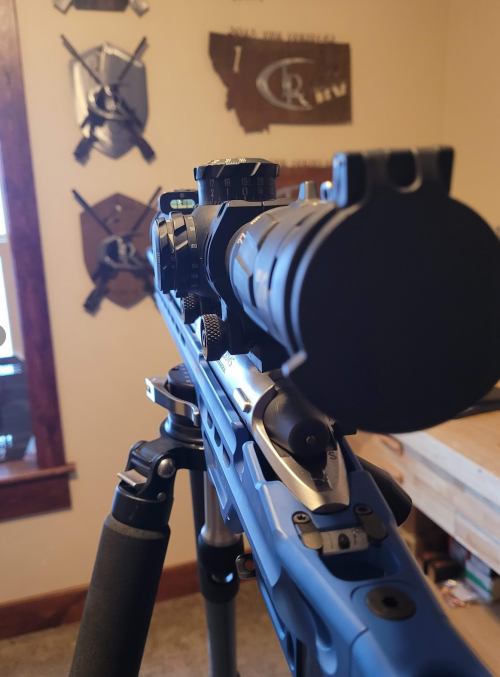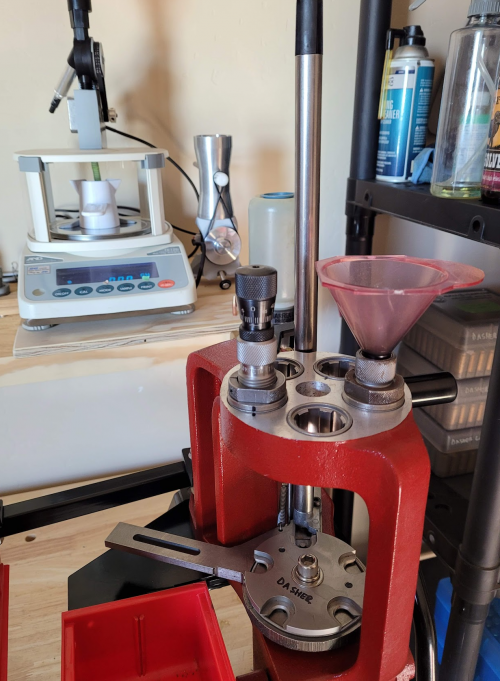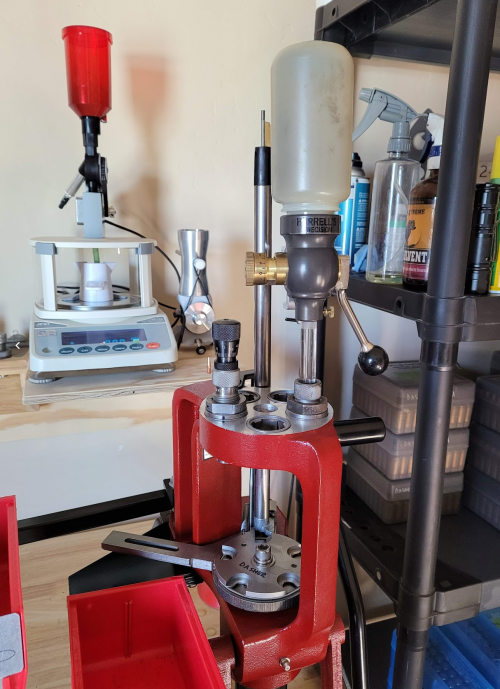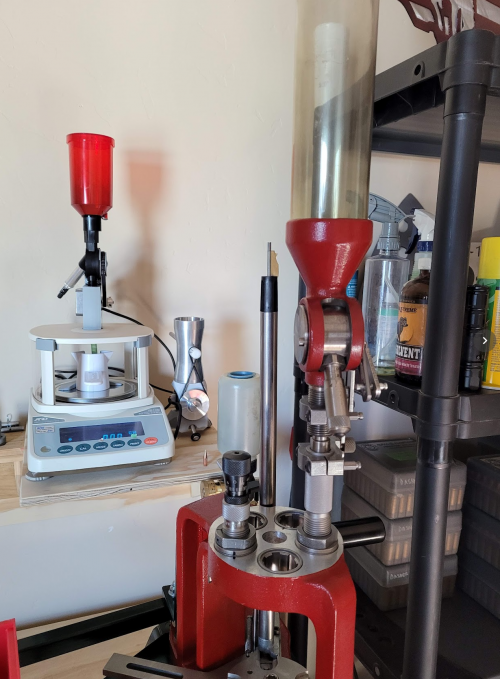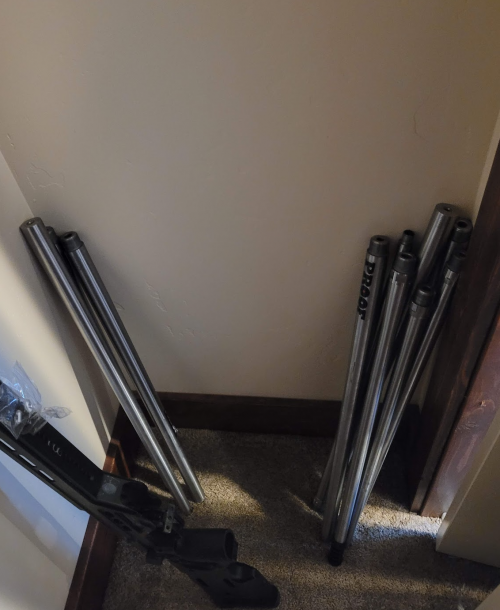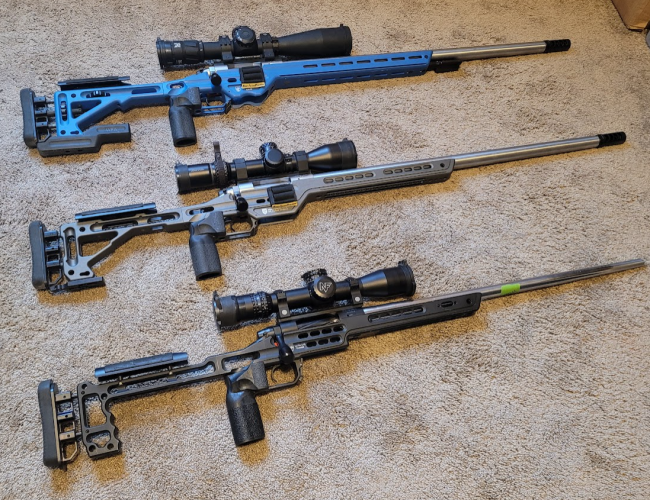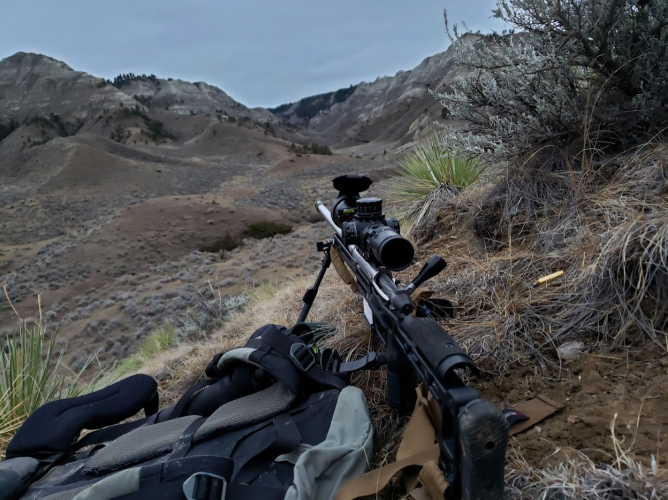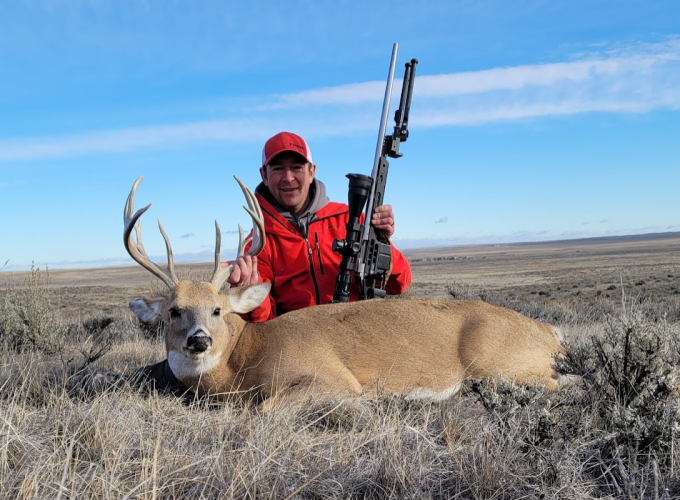At @Greenhorn 's request from a couple months ago, I’m going to go through my competition rifle setup. I know this won’t directly apply to most here, and that there are other places on the internet specifically aimed at this sort of thing. Hopefully there will be some value for some of you.
My specific game of choice has been PRS/NRL style competition. I’ve shot plenty of national level 2-day matches affiliated with those leagues, but have backed off a bit to just the more local stuff the past year.
My setup is a very common competitive setup for this style of match. Everyone has their favorite flavor, but there’s more convergence now on what top guys run than there was 5-6 years ago. If you’re in that world or follow guys online who are, none of this will be new.
Also, not trying to splash all the trophies in everyone’s face. Just how my reloading room is decorated. If you compete at something regularly for close to a decade and are decent at it, you can accumulate a few.
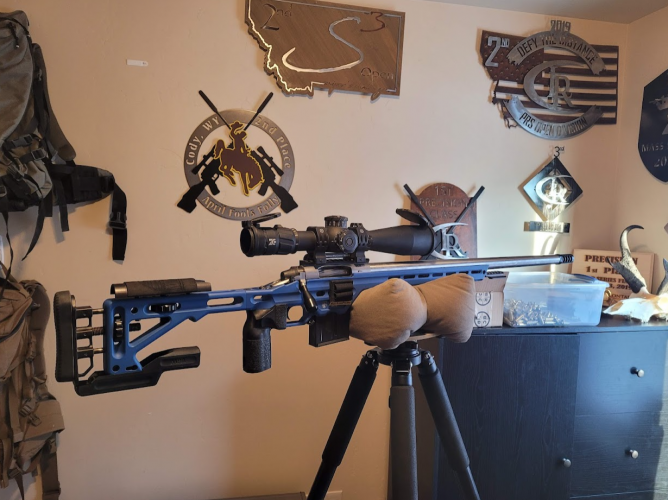
Here is my current comp rifle. I change things up often whenever I get curious about something, but the formula has been pretty locked in since 2017. The specs are:
Bighorn (now Zermatt) TL3-SA
Masterpiece Arms ESR Chassis
Zero Compromise 5-27x56 w/ MPCT 2 reticle in an ARC M-Brace mount
Proof Prefit in 6 Dasher, Competition Contour, 1-7.5 twist, 26” long, 5/8-24 threaded muzzle
Trigger Tech Diamond Pro Curve – Single stage – set at 12 oz
This setup is ~ 18 lbs as you see it, ~ 19.5 lbs with the bipod that’s normally on it. As you can kind of see in the picture, the center of gravity is a few inches in front of the recoil lug. This is how I want my gun to balance, because it’s often I will shoot my gun balanced on a single bag as it is here. Weight kits have become very popular in the last few years; you can use them to fine tune the balance point, or just to make your rifle extra obscenely heavy. I have a whole stash of weights, but with the 7ish lb Proof Comp Contour barrel in this chassis I don’t need them to change the balance point, and I’m done making my rifle any heavier than this just for the very minor possible advantages.
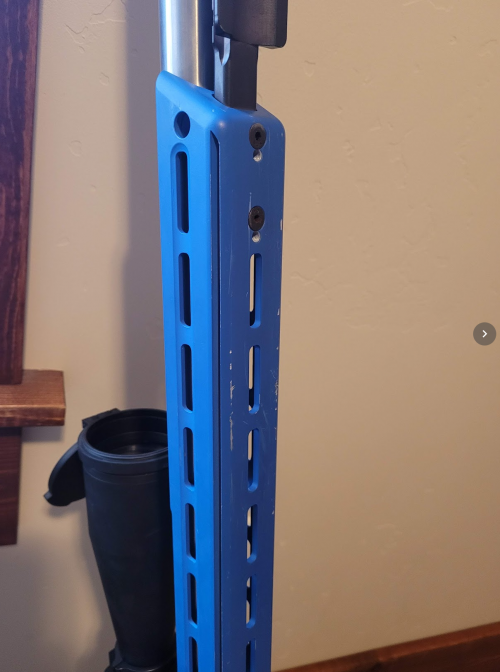
Here you can see the fore-end of the chassis, and I’m specifically trying to show the Arca-Swiss dovetail cut into the bottom. That’s used for attaching bipods, tripods, and other plates and accessories, AND being able to position them anywhere along the fore-end as the specific shooting situation requires. It’s been the standard in the precision rifle competition community for a few years now.
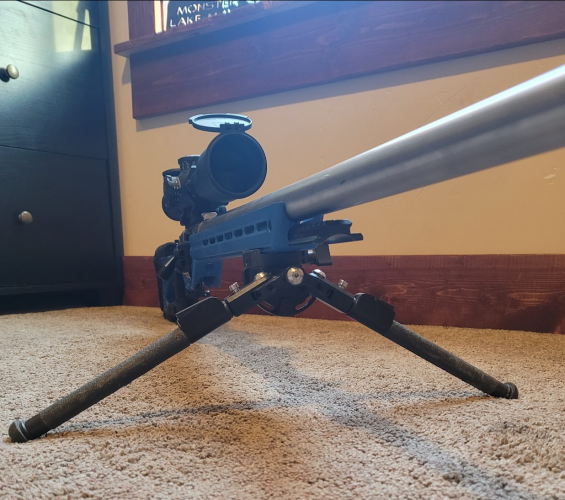
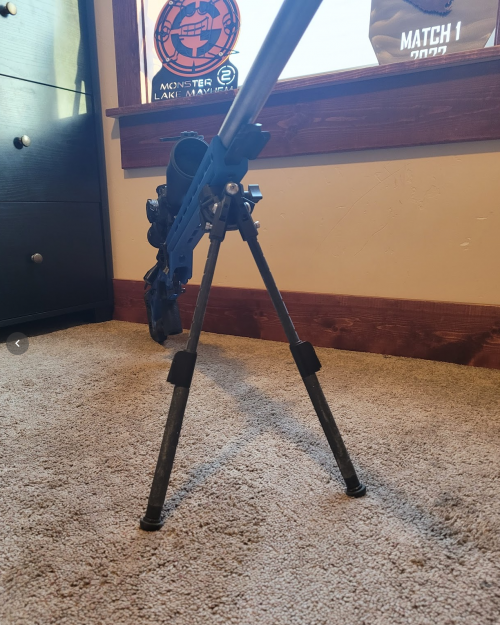
The bipods I use almost exclusively are Ckyepods, created by Ckye Thomas who sold or licensed to MDT. They’re also “fully priced” and then some. The legs can change in both length and angle, and very quickly at that. Above you can see the extremes of how high and low it'll go, but there are many steps in between.
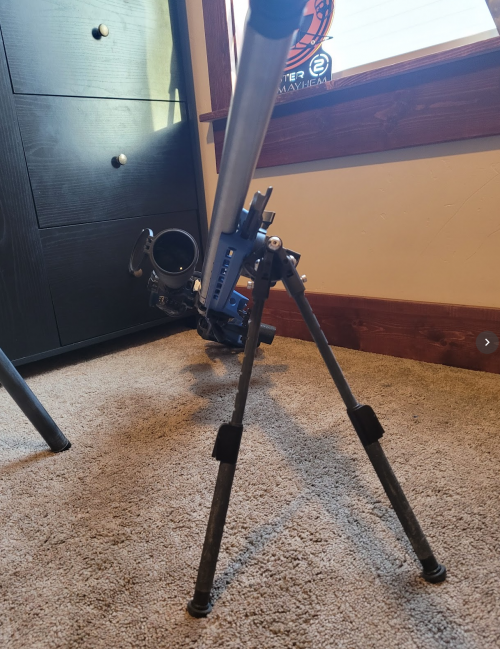
They also have ALL the cant adjustment, as shown above. No worries about leveling out in angled terrain, I’ve shot prone with them off some steep sidehills and didn’t have to think about leveling the bipod at all. Pull the legs out, rotate the gun to level, and you’re ready to shoot.
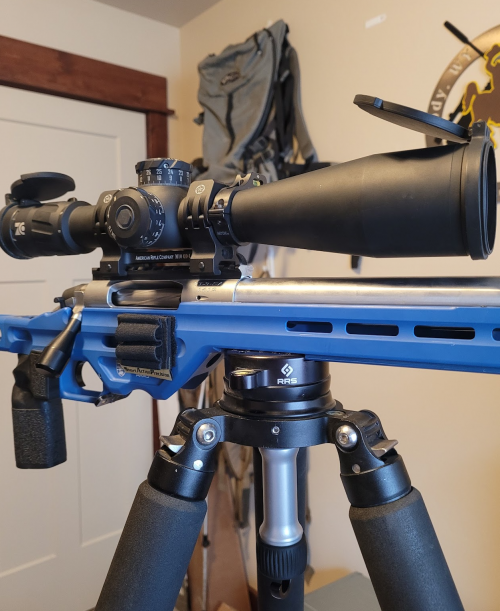
My tripod head also can clip into the Arca-Swiss dovetail on the fore-end and hold the rifle very effectively. With practice you can hold less than an MOA of wobble from the standing, and close to perfect from sitting. Recoil management does change a fair amount with it directly clipped in and not for the better. That tripod is a Feisol 3372 with an RRS leveling base on top. It’s just under 5 lbs. If your familiar with the RRS Anvil 30 setup, I think it is a better all around package when you look at compactness and angle (the leveling base goes +/- 15 degrees is all). If you’re using it to shoot while clipped in, I don’t think anything will beat my style setup at the weight point.
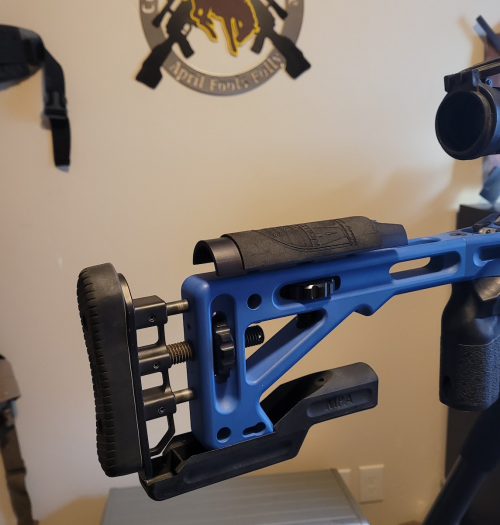
One great thing about most chassis systems is the amount of adjustment available to make the rifle fit you well. The length of pull can be changed. The recoil pad on mine is shifted up to be more in line with the bore axis and minimize any moment that would be created by recoil. The cheek riser is adjustable in height, and…
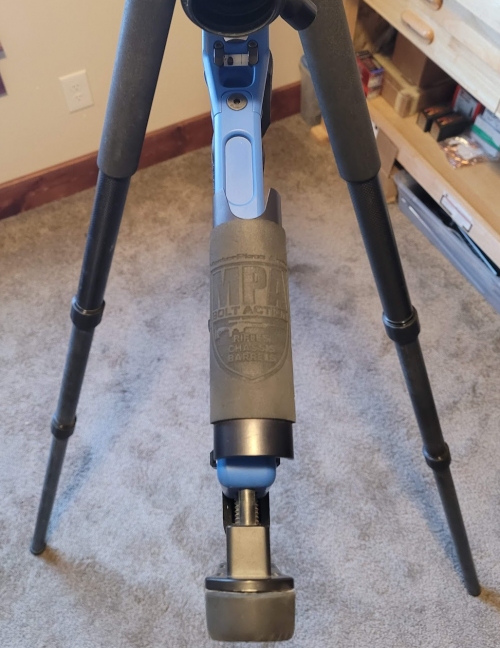
As is shown in this image the cheekpiece on mine can be shifted off center. My face meshes with it best when it’s shifted to the right. Setup like this, when I get on the gun I’m relaxed and looking through the center of the scope. It’s just comfortable, if you are me.
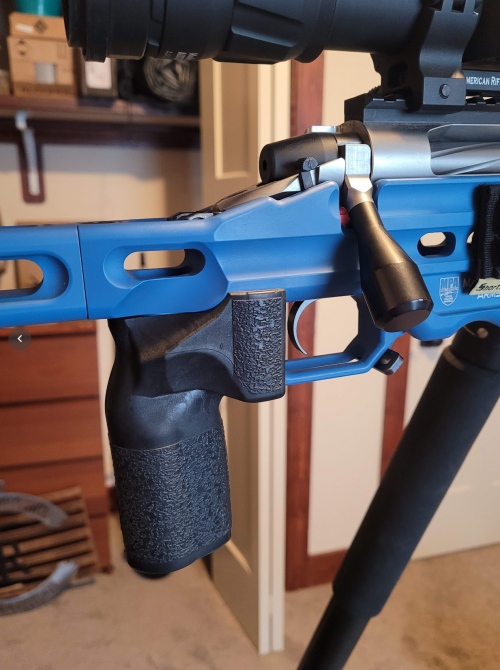
One of my favorite parts of this chassis is the grip. This is the Enhanced Vertical Grip from MPA, and when they released it and the offset cheekpiece is when I decided to give them a try ~ 6 years ago. It puts my hand exactly where I want it and puts my trigger finger at 90 degrees to the trigger with a very relaxed hand:
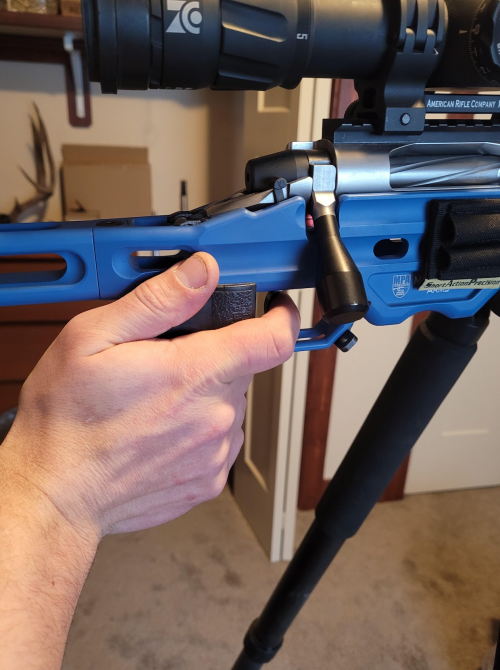
My grip, as good as I can take a picture of it myself. The thumb forward grip is very popular in precision rifle competition. It is best saved for guns that don’t recoil much, but that’s what everyone shoots in competition anyways.
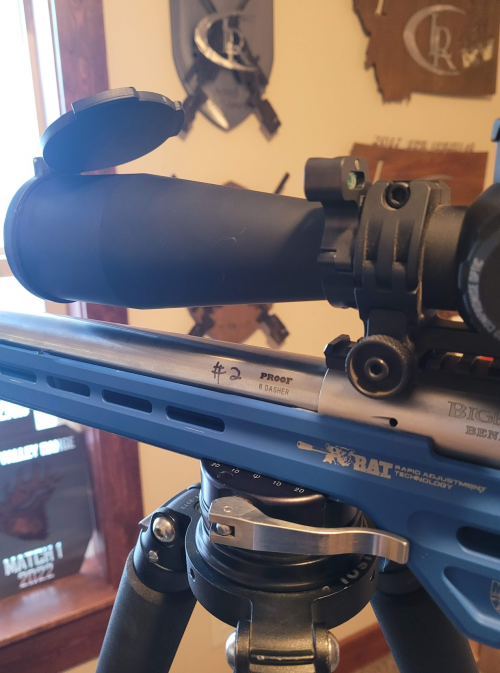
I’ve been running Proof Prefit barrels for competition and also for my 223 practice barrel. I’ve got 3 of their 6mm Dasher barrels that are identically marked, so I number them to keep them straight. If you aren’t familiar with Prefit’s, many custom action makers's tolerances are consistent enough that Proof can cut a shouldered barrel, ship it to you, and be confident it’ll work correctly with your action. Very convenient, they have shot as good as anything I’ve ever had, and they are nicely priced on top of all that. You do lose the customization options you’d have with a traditional gunsmith.
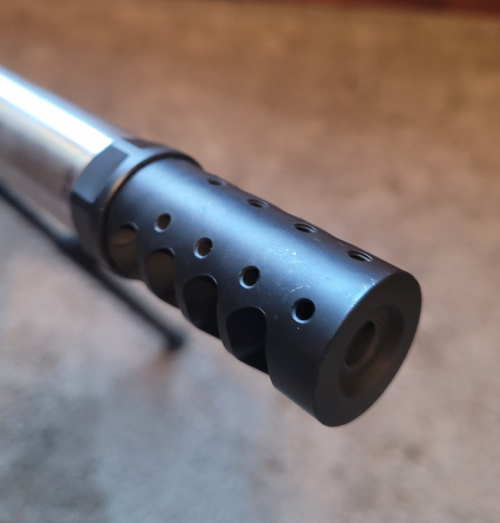
This is my muzzle break, an APA Little Bastard Gen 3. The ports on the top are threaded and come with set screws so you can tune it to reduce muzzle rise. I run mine wide open, and muzzle rise does NOT occur. To put in perspective how effective it is, I was training with a 223 setup just like this, except I didn’t have a muzzle break on it. So, a 18+ lb 223 with good ergonomics but a bare muzzle. It had enough more muzzle rise than my Dasher WITH this break, that I put one on the 223 to make the training more effective.
Why so much emphasis on muzzle rise? Seeing your hits, misses, and bullet trace perfectly will greatly increase the accuracy of your windage call after the first shot of your stage. Seeing it well and adjusting to that information correctly on the clock is a big difference between shooters. The less muzzle rise, the easier everything is to see, especially from highly compromised positions.
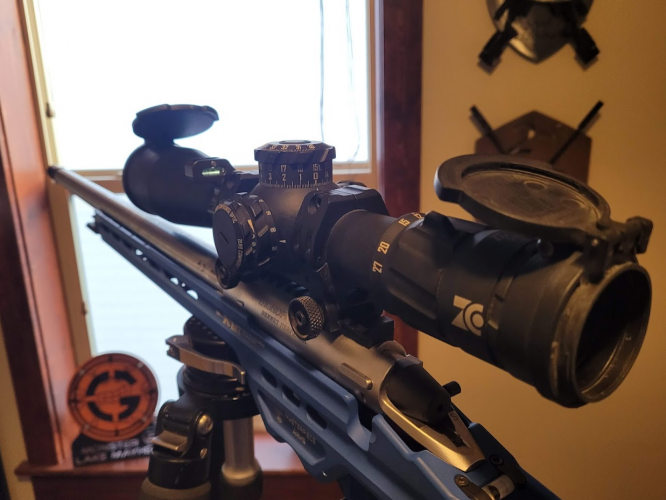
Good optics help with spotting for certain, and this qualifies. It’s a Zero Compromise 5-27, has VERY good glass, and is worth more than the rest of the rifle put together. While it goes to 27, I spend the most time in the 12-16 power range. I bought it used and it came with the mount. It’s a high quality mount, but I’d personally prefer separate rings, and rings that were a bit lower. May make the switch at some point.
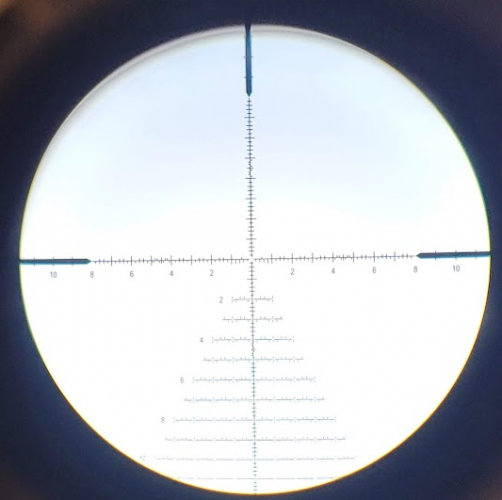
The reticle in mine is an MPCT 2. Reticles are personal preference to a degree. I don’t think this one is 100% perfect, but it’s VERY close for my taste. I’m a big fan of the .2 mil windage marks, the way the tree doesn’t start until 2 mils below the middle, the floating center dot, and the reticle line weight. It isn’t nearly as thin in person as it looks in this image.
I’ll touch on my load real quick. Most recently I’ve been shooting:
109 Berger Hybrids
.035” jump
H4895, 29 to 30+ gr and sometimes thrown instead of weighed
Alpha brass
CCI 400 primers
I honestly think the Dasher case, a good bullet, and a good powder do 90% of the heavy lifting for keeping velocity spreads tight, add in the barrel and IMO you’ve got 90% of your accuracy variables. I’ll say loading for 8 Dasher barrels now, I’ve hardly ever put together a combination that couldn’t win your average 1 day match. I’ve basically quit load development other than finding a velocity I’m comfortable with. I think the common load development methods of OCW and ladders are just looking at noise for everyone shooting below the F-class or 1000 yd BR level, and that includes me. But to give a reference point, 10 shot groups are typically between .4 and .6 inches, my last 20 shot was .8 but I think some of that was lighting conditions changing while I let my barrel cool. A typical 10 shot string would have an ES in the 18-20 range as measured by a Magnetospeed. One thing I really like about this sport is that there’s a “good enough” accuracy, whereas in Benchrest there isn’t. With todays bullets, powders, and barrels it’s pretty simple to hit that “good enough” point, so you can move on and work on shooting.
I’m going to cut it off here, as I’ve exceeded 1600 words. On top of which, this is a hunting site, and this is NOT a hunting rifle even for me. If you have questions, ask away. If there’s interest I could also expand into my rifles-as-a-system thing I have going, more on loads and accuracy, or handloading processes. Just let me know.
My specific game of choice has been PRS/NRL style competition. I’ve shot plenty of national level 2-day matches affiliated with those leagues, but have backed off a bit to just the more local stuff the past year.
My setup is a very common competitive setup for this style of match. Everyone has their favorite flavor, but there’s more convergence now on what top guys run than there was 5-6 years ago. If you’re in that world or follow guys online who are, none of this will be new.
Also, not trying to splash all the trophies in everyone’s face. Just how my reloading room is decorated. If you compete at something regularly for close to a decade and are decent at it, you can accumulate a few.

Here is my current comp rifle. I change things up often whenever I get curious about something, but the formula has been pretty locked in since 2017. The specs are:
Bighorn (now Zermatt) TL3-SA
Masterpiece Arms ESR Chassis
Zero Compromise 5-27x56 w/ MPCT 2 reticle in an ARC M-Brace mount
Proof Prefit in 6 Dasher, Competition Contour, 1-7.5 twist, 26” long, 5/8-24 threaded muzzle
Trigger Tech Diamond Pro Curve – Single stage – set at 12 oz
This setup is ~ 18 lbs as you see it, ~ 19.5 lbs with the bipod that’s normally on it. As you can kind of see in the picture, the center of gravity is a few inches in front of the recoil lug. This is how I want my gun to balance, because it’s often I will shoot my gun balanced on a single bag as it is here. Weight kits have become very popular in the last few years; you can use them to fine tune the balance point, or just to make your rifle extra obscenely heavy. I have a whole stash of weights, but with the 7ish lb Proof Comp Contour barrel in this chassis I don’t need them to change the balance point, and I’m done making my rifle any heavier than this just for the very minor possible advantages.

Here you can see the fore-end of the chassis, and I’m specifically trying to show the Arca-Swiss dovetail cut into the bottom. That’s used for attaching bipods, tripods, and other plates and accessories, AND being able to position them anywhere along the fore-end as the specific shooting situation requires. It’s been the standard in the precision rifle competition community for a few years now.


The bipods I use almost exclusively are Ckyepods, created by Ckye Thomas who sold or licensed to MDT. They’re also “fully priced” and then some. The legs can change in both length and angle, and very quickly at that. Above you can see the extremes of how high and low it'll go, but there are many steps in between.

They also have ALL the cant adjustment, as shown above. No worries about leveling out in angled terrain, I’ve shot prone with them off some steep sidehills and didn’t have to think about leveling the bipod at all. Pull the legs out, rotate the gun to level, and you’re ready to shoot.

My tripod head also can clip into the Arca-Swiss dovetail on the fore-end and hold the rifle very effectively. With practice you can hold less than an MOA of wobble from the standing, and close to perfect from sitting. Recoil management does change a fair amount with it directly clipped in and not for the better. That tripod is a Feisol 3372 with an RRS leveling base on top. It’s just under 5 lbs. If your familiar with the RRS Anvil 30 setup, I think it is a better all around package when you look at compactness and angle (the leveling base goes +/- 15 degrees is all). If you’re using it to shoot while clipped in, I don’t think anything will beat my style setup at the weight point.

One great thing about most chassis systems is the amount of adjustment available to make the rifle fit you well. The length of pull can be changed. The recoil pad on mine is shifted up to be more in line with the bore axis and minimize any moment that would be created by recoil. The cheek riser is adjustable in height, and…

As is shown in this image the cheekpiece on mine can be shifted off center. My face meshes with it best when it’s shifted to the right. Setup like this, when I get on the gun I’m relaxed and looking through the center of the scope. It’s just comfortable, if you are me.

One of my favorite parts of this chassis is the grip. This is the Enhanced Vertical Grip from MPA, and when they released it and the offset cheekpiece is when I decided to give them a try ~ 6 years ago. It puts my hand exactly where I want it and puts my trigger finger at 90 degrees to the trigger with a very relaxed hand:

My grip, as good as I can take a picture of it myself. The thumb forward grip is very popular in precision rifle competition. It is best saved for guns that don’t recoil much, but that’s what everyone shoots in competition anyways.

I’ve been running Proof Prefit barrels for competition and also for my 223 practice barrel. I’ve got 3 of their 6mm Dasher barrels that are identically marked, so I number them to keep them straight. If you aren’t familiar with Prefit’s, many custom action makers's tolerances are consistent enough that Proof can cut a shouldered barrel, ship it to you, and be confident it’ll work correctly with your action. Very convenient, they have shot as good as anything I’ve ever had, and they are nicely priced on top of all that. You do lose the customization options you’d have with a traditional gunsmith.

This is my muzzle break, an APA Little Bastard Gen 3. The ports on the top are threaded and come with set screws so you can tune it to reduce muzzle rise. I run mine wide open, and muzzle rise does NOT occur. To put in perspective how effective it is, I was training with a 223 setup just like this, except I didn’t have a muzzle break on it. So, a 18+ lb 223 with good ergonomics but a bare muzzle. It had enough more muzzle rise than my Dasher WITH this break, that I put one on the 223 to make the training more effective.
Why so much emphasis on muzzle rise? Seeing your hits, misses, and bullet trace perfectly will greatly increase the accuracy of your windage call after the first shot of your stage. Seeing it well and adjusting to that information correctly on the clock is a big difference between shooters. The less muzzle rise, the easier everything is to see, especially from highly compromised positions.

Good optics help with spotting for certain, and this qualifies. It’s a Zero Compromise 5-27, has VERY good glass, and is worth more than the rest of the rifle put together. While it goes to 27, I spend the most time in the 12-16 power range. I bought it used and it came with the mount. It’s a high quality mount, but I’d personally prefer separate rings, and rings that were a bit lower. May make the switch at some point.

The reticle in mine is an MPCT 2. Reticles are personal preference to a degree. I don’t think this one is 100% perfect, but it’s VERY close for my taste. I’m a big fan of the .2 mil windage marks, the way the tree doesn’t start until 2 mils below the middle, the floating center dot, and the reticle line weight. It isn’t nearly as thin in person as it looks in this image.
I’ll touch on my load real quick. Most recently I’ve been shooting:
109 Berger Hybrids
.035” jump
H4895, 29 to 30+ gr and sometimes thrown instead of weighed
Alpha brass
CCI 400 primers
I honestly think the Dasher case, a good bullet, and a good powder do 90% of the heavy lifting for keeping velocity spreads tight, add in the barrel and IMO you’ve got 90% of your accuracy variables. I’ll say loading for 8 Dasher barrels now, I’ve hardly ever put together a combination that couldn’t win your average 1 day match. I’ve basically quit load development other than finding a velocity I’m comfortable with. I think the common load development methods of OCW and ladders are just looking at noise for everyone shooting below the F-class or 1000 yd BR level, and that includes me. But to give a reference point, 10 shot groups are typically between .4 and .6 inches, my last 20 shot was .8 but I think some of that was lighting conditions changing while I let my barrel cool. A typical 10 shot string would have an ES in the 18-20 range as measured by a Magnetospeed. One thing I really like about this sport is that there’s a “good enough” accuracy, whereas in Benchrest there isn’t. With todays bullets, powders, and barrels it’s pretty simple to hit that “good enough” point, so you can move on and work on shooting.
I’m going to cut it off here, as I’ve exceeded 1600 words. On top of which, this is a hunting site, and this is NOT a hunting rifle even for me. If you have questions, ask away. If there’s interest I could also expand into my rifles-as-a-system thing I have going, more on loads and accuracy, or handloading processes. Just let me know.




